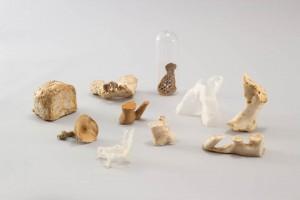As we have mentioned before, one of the few downsides to 3D printing is the plastic waste created by all the prints. We have seen many bioplastics come to market, as well as methods of recycling plastic bottles and old 3D 
One artist from The Netherlands, Eric Klarenbeek, has gone a step further than just recycling plastics, or using bioplastic filament. He has come up with an innovative, and very artistic method of 3D printing with fungus… Yes Fungus!
The process used by the 35-year-old artist is quite amazing. He takes ground up straw, and infuses it with Mycelium fungus. The fungus is known for taking a liking to straw, thus the reason for its use. He uses this material as sort of a filament within a large 3D printer. The printer works just like any other FDM printer, slowly extruding the straw and mycelium mixture, layer by layer, until a desired configuration is created. Unlike FDM printers, however, there is no need for heat. Instead of melting plastics, Klarenbeek relies on nature to do its work. Once an object is printed out using his mixture, he soaks it in water, and lets it sit for a couple of days. Slowly the mycelium fungus takes hold. As it grows, it replaces the water, fusing together the straw mixture. The end result is a solid structure which is extremely light in weight, kind of like that of cork.
“We adapted the 3D-printer and invented a way to print straw injected with mycelium. By infusing this mushroom it acts as a kind of glue so that all these straw parts [come] together and as soon as you dry it you get a kind of cork material, which is all bound together,” says Klarenbeek.”
Klarenbeek then uses bioplastic to 3D print a very thin outer shell which mimics the shape of that of the straw mixture. He places the 3D printed mycelium infused straw into the plastic shell, and allows it to continue to grow. After a couple of days he has a very solid, structurally stable object. An example would be the chair you see in the picture above. Like you can see, as evidence that the mycelium is intertwined throughout the object,
mushrooms tend to grow from the 3D prints.
“This chair is really a metaphor for what could be made with this technique of 3D printing a living organism and then have it grow further,” says Klarenbeek. “It could be a table, a whole interior or even a house. We could build a house with it.”
Although we may not be seeing houses made from straw and mushrooms anytime soon, the method used here is certainly one that is quite intriguing. Because the printed straw does not need to be heated while extruded, it saves significantly on energy costs. In addition, when the printed object is no longer needed, it can be composted, and broken down in someone’s garden. In fact it would make an exception fertilizer.
What do you think of Klarenbeek’s work. Could this method of 3D printing have a future? Will we be building homes out of mushrooms some day? Let us know in the 3D printed Mycelium Fungus forum thread on 3DPB.com. Check out the video below where Klarenbeek explains his work in further detail.
[Source: EricKlarenbeek.com